Hot Cross Bun anyone? The Mary Mallatratt's Dole
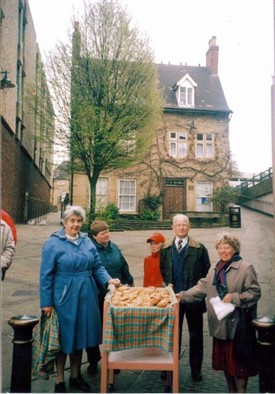
The distribution in 2004 on Stockwell Street
COPYRIGHT RBParish
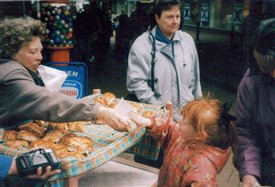
The distribution on Stockwell street in 2004
COPYRIGHT RBParish
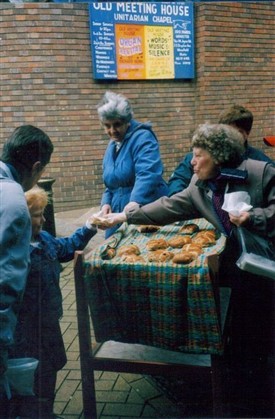
The distribution on Stockwell street in 2004
COPYRIGHT RBParish
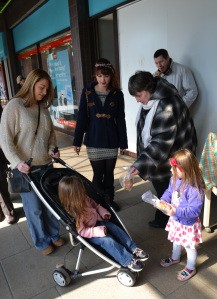
Distribution outside of Argos in 2013
COPYRIGHT RBParish
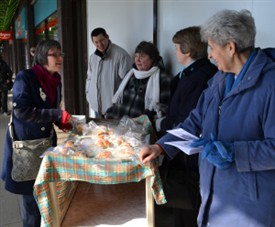
Not just children in 2013
COPYRIGHT RBParish
An Easter custom
By R B Parish
Good Friday was a traditional day for giving doles and Nottinghamshire was not an exception. Many of these were charities set up by local worthies in their wills. For example Christopher Sudbury’s Charity gave money on this day in Edwinstowe, and at Hucknall, the ‘Widow’s Groat’ was given to 15 poor widows by the minister and churchwardens, from the annual rent of 15s from a piece of land called ‘Crown Piece’. Many of these doles were in the form of bread, for example, 30s worth (Lowdham) 14s worth (Warsop), 1s worth (Ordsall) and 6d loaves to poor widows and 1d loaf to poor persons (Eakring), and Upton’s Tinlay’s Charity which gave 4d in six loaves after the service. All these doles appear to have died out, many fell afoul of the Charity Commission, being usually amalgamated into other doles and converted into monies used for care for the elderly, usually at the First or Second World Wars.
However there is one the Good Friday dole tradition which is still maintained, although little known and not recorded in any countrywide volume on customs, this is Mary Mallatrat’s Dole which was established in 1894 in her will. It is said that dole was established to remember Mary’s child who died as an infant of brain damage aged 7 months in 1876, although this is not explicitly stated. Certainly the Mansfield and North Notts Advertiser (1931) stated that even before Mary’s death it was customary to give free buns out at Easter to children at the Blue Boar Inn, so clearly Mary wanted to see this custom being perpetrated in perpetuity. After the death of her son, Mary became increasingly involved with the affairs of the Meeting House and so after her death it was not surprising that she gave monies for school books for it, money for a stained glass window and the bequest of £100 to the trustees of the Meeting house to provide buns annually. It appears to have survived an attempt at amalgamation with similar charities and the two world wars when it ceased to be given out and is consists of ‘hot cross buns’ given to children as they go about their business on Good Friday. As Mallatrat (2003) notes each year the distribution grew in size. The largest distribution being in 1912 when a local coal strike happened and 2000 buns were distributed! (And it still was not enough!) The Mansfield Reporter noted:
“The magic of the Good Friday Bun drew a crowd of over a couple of thousand of Mansfield’s poor children to the Old Meeting House on Friday morning. For the past 14 or 15 years in accordance with a bequest it has been the custom to distribute buns in the grounds of this place of worship, the number usually being given usually 1200. This year in consequence of the coal strike, some additional funds were obtained from private sources, and the number of buns increased to 2000. The distribution is a popular annual event and on the Friday morning children began to gather as early as seven o’clock, three hours before the specified time in Rooth Street. By 10 o’clock a long queue of youngsters from babies of 2 and 3 years of age in the arms of big brothers and sisters, to boys and girls of 10 and 12 years old, stretched the whole length of the street and overflowed into Rosemary Street. It was a miserable morning-the first one known to be wet in the distribution-but the children stood patiently in the long line and at 10 o’clock when the big doors opened, two thousand shrill voices cheered. Police officers let them in by batches and the little ones filed past the table, each received a bun from either Mr. J.H. White, Mr. Birks or Mr. Roper or one of the several ladies who took part in the distribution. So great was the number of applicants that the supply ran short, and about 200 were disappointed.”
Unlike similar charities, the Mallatrat Trustees missed the opportunity during the last War to commute the buns for cash and although the original gift no longer covers the expense, the Chapel Trustees subsidise the distribution so it does continue. Times have changed and the size of the distribution is not as daunting. The Guardian Journal in 1973 noted that only 73 turned up to collect 200 buns (which appeared to the children to be a good ratio no doubt) which was done of the previous year and the author of the piece suggested this was due to demolition of housing in the area.
It notes :
“First in line was 13 year old Christopher Simpson, Richard Street, Mansfield who arrived at 8.50 am 10 minutes before the gates opened. In the past children where queuing up as early as 7.30 to get the buns.”
In 1994 to celebrate the 100th anniversary of the distribution an exhibition on the history of the custom was established, and perhaps indicating how cultural views have changed Rev Michael Joyce said:
“Nowadays it’s pretty hard work trying to get children to accept them”
In 1994 he was joined by the descendants of the Mallatratts. Despite the decline, the Old Meeting House still distributes their dole, but no one lines up for it now. It is now presented on a trolley rolled down to the High Street below and much to the bemusement and sometimes mistrust of the local children they hand out their buns still free of charge. Hopefully since it is now recorded on their website more interest in the custom may be generated.
Local tradition records to earn a bun you had to complete a circuit –out of the gates of Stockwell gate, right to Rosemary Street, along and right into Rooth street, through the meeting house main gates and into the hall.
References
Mallatratt, A (2003) Mary Mallatrat and the Hot Cross Bun Legacy,Nottinghamshire Historian Summer 2003 No.78